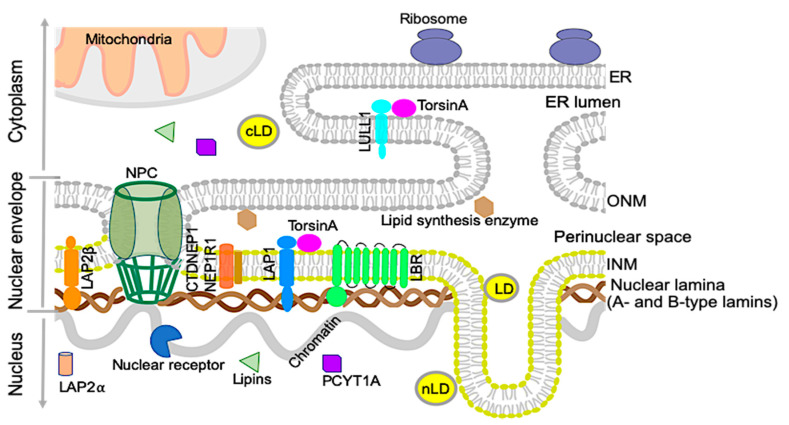Figure 1.
The organization of the nuclear envelope and endoplasmic reticulum (ER). Schematic diagram of the nuclear envelope and ER showing the nuclear membranes, nuclear lamina, and nuclear pore complex (NPC). The nuclear lamina contains A- and B-type lamins. The outer nuclear membrane (ONM) is contiguous with the ER, containing lipid synthesis enzymes and ribosomes. The ER lumen is directly continuous with the perinuclear space. Selected proteins, such as lipid synthesis enzymes concentrated in the ER and inner nuclear membrane (INM), are shown along with torsinA in the perinuclear space. Lamina-associated polypeptide 1 (LAP1) is shown interacting with lamins and torsinA. Two isoforms of LAP2 are shown in the nucleoplasm (LAP2α) and INM (LAP2β). Some of the nuclear receptors that regulate gene expression are known to interact with nuclear lamins or lamin-associated proteins. Some enzymes involved in phospholipid biogenesis (CTDNEP1/NEP1R1, lipins, and PCYT1A) are localized in the nucleus or NE. TorsinA interacts with LAP1 at the nuclear envelope (NE) and luminal domain-like LAP1 (LULL1) in the main ER. Lipid droplets are mainly synthesized in the ER and present in the cytosol as cytosolic lipid droplets (cLDs). Certain types of cells contain nuclear lipid droplets (nLDs) within the nucleus. Mitochondria and ribosomes are localized in the cytoplasm.

